We know that continuous learning is important for individuals and organizations to innovate in the midst of disruption. How can organizations foster a continuous learning mindset? What if individuals were encouraged to create content?
Adam Kingl, an author, educator, keynote speaker and consultant, believes this to be the case. He wrote the book Next Generation Leadership: How to Ensure Young Talent Will Thrive with Your Organization, published by HarperCollins in 2020.
Career Innovation
 The spark for Adam’s book was ignited back in 2009 when he was working with young, high potential talent while leading a London Business School executive education program. Adam was struck by these individuals’ perspectives on work, life and leadership. He set out to investigate these paradigms, conducting surveys that would shed light on how better to lead younger generations. As he progressed on this journey, he realized that the book would really be focused on the future of work.
The spark for Adam’s book was ignited back in 2009 when he was working with young, high potential talent while leading a London Business School executive education program. Adam was struck by these individuals’ perspectives on work, life and leadership. He set out to investigate these paradigms, conducting surveys that would shed light on how better to lead younger generations. As he progressed on this journey, he realized that the book would really be focused on the future of work.
“That conclusion was driven from the interviews,” said Adam. “It is one of those things when every time you get new data, that poses new questions that send you in new directions. The question came first, then the research, then that led to content creation that in turn led to new questions and avenues of research.”
Adam went on to make a very important point: “To be honest, it never ends. I have even more questions. When I have written articles about some aspect of the book, I often delve into new questions and conversations that aren’t even in the book.”
Creating smart content also leads to new business opportunities that oftentimes wouldn’t be possible otherwise. One of Adam’s main speaking topics these days is Generation Y Paradigms of Work and Leadership. A thoughtful and robust book on the topic provides the credibility to address the topic.
“If you want to consider yourself a thought leader, you have to generate thinking that is relevant to the world,” Adam said. “Creating relevant, new content leads to new opportunities.”
Content journeys are unique to each person’s experiences and interests. Adam is now working on a new book that will focus on what traditional businesses can learn from the arts in terms of enhancing innovation, inspiration and adaptability. Adam can bring unique insights on this topic by combining his research with his own experience as a theater director at the outset of his career.
“I didn’t initially think I would have a career in business,” Adam said. “The reason I got into business is I realized that some of the theaters weren’t very good at managing themselves as sustainable ventures. I sort of fell into the world of business because I was thinking about how these theaters could improve beyond their artistic planning. Now, 20 years later, I have a first-hand perspective at what business can learn from the arts. My next book is an attempt to bring those two worlds in my life together because I do think there is a dialogue in which there is something they can teach each other.”
Networking
We all know the importance of networking. New contacts, former colleagues and friends can be the gateway to opportunities and sounding boards for advice on different challenges. As noted in this article, “content learning” can play an important role in growing our networks.
Adam can attest to this as he went through his journey of writing the second book, through which he has been able to reconnect with his colleagues from his days working in the arts.
Final thoughts and questions to consider
Google the term “continuous learning” and you will see many characteristics: it is ongoing, voluntary and self-motivated to name a few. These characteristics have been on display throughout Adam’s content journey. Perhaps there are aspects of Adam’s content journey to consider for yourself to support continuous learning.
What is something in which you want to be an expert? Once you identify that, how can you create content around it? How can you leverage and enhance your network in the process? Can you envision how your content journey might take you down new and different paths?
Adam raised an excellent point at the conclusion of our interview by sharing typical assumptions that he has heard from L&D departments that they need to break. First, is the notion that the only time to invest in learning is when participants are on a formal program. Second is the idea that only outside experts present and facilitate, as opposed to having internal colleagues teach as well.
This begs a few questions if you work in an L&D role or if you are a leader concerned about fostering continuous learning among your team:Are you creating avenues for your colleagues to contribute content that will help them evolve in the next steps of their career? Are you encouraging them to tap into their previous experiences and future aspirations while connecting to present objectives? If you have existing learning programs in place, have you considered equipping participants to create content – such as a white paper, presentation or article – based on their learning that can then be cascaded to others in the organization?
Just imagine as we head into 2021 if individuals in your organization dedicated 1-2 hours a week throughout the year to creating content that relates to their personal development and the organization’s key priorities. What questions might emerge that could help your organization to differentiate itself from the competition? What opportunities might you discover?
[thrive_leads id=’2432′]

